Now that the turkey is done and the holiday season has started, we can look back on what we played in November. Judging by the diverse types of games in this month’s entry, it’s safe to say that our staff and readers have been quite busy (all eating aside).
Chiki Chiki Boys By Ken Horowitz
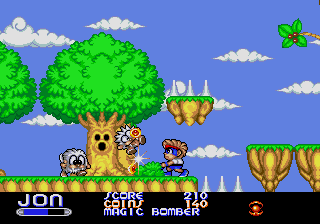 This is a game I come back to every so often. It doesn’t get the acclaim it deserves, most likely owed to people thinking it’s a Monster World clone (like that could be a BAD thing) or an overall lack of familiarity with its arcade heritage. Chiki Chiki Boys is an excellent action/adventure title whose only fault (aside from being single-player only) is not having a password feature. Sure, it’s not Kid Chameleon long, but it does stretch on longer than one would expect. I say this is a fault not in a negative way, mind you. I wish it had the password feature so that I wouldn’t be forced to play it all in one sitting and risk having to leave or shut off my Genesis for some reason. This is a game I like to take my time with – enjoy the lush, colorful and detailed graphics, the catchy soundtrack, and search for all those darn hidden chests!
This is a game I come back to every so often. It doesn’t get the acclaim it deserves, most likely owed to people thinking it’s a Monster World clone (like that could be a BAD thing) or an overall lack of familiarity with its arcade heritage. Chiki Chiki Boys is an excellent action/adventure title whose only fault (aside from being single-player only) is not having a password feature. Sure, it’s not Kid Chameleon long, but it does stretch on longer than one would expect. I say this is a fault not in a negative way, mind you. I wish it had the password feature so that I wouldn’t be forced to play it all in one sitting and risk having to leave or shut off my Genesis for some reason. This is a game I like to take my time with – enjoy the lush, colorful and detailed graphics, the catchy soundtrack, and search for all those darn hidden chests!
If you like the Monster World series, than this one’s a no-brainer. It’s well worth the cost (which isn’t much. I do wish it had been a two-player game, as that would have made it a blast to play through with a friend, but even as-is, it’s a rock-solid title. Oh Chiki Chiki boys, why won’t you come back to us?
Lunar: The Silver Star Touch By Sebastian Sponsel
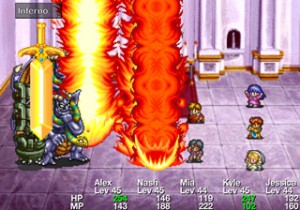 November was one of those months where I didn’t find much time for playing video games, and my beloved Mega Drive actually never was turned on once. Ironically though, one of the few games I started this month was an RPG. Lunar: the Silver Star is probably the RPG that has received the most “enhanced” ports to newer generation consoles. Heck, it even got more of those ports than Chrono Trigger! After the original version for the Mega CD we already got Lunar: Silver Star Story Complete for the PSX, Lunar Legend for the GBA and Lunar: Silver Star Harmony for the PSP. Yeah, these have some deviations here and there, but basically it’s all still the same game. And now we also got Lunar: Silver Star Story Touch for iOS. It’s been exactly 20 years since the original was released for the Japanese Mega CD. Why is there such a need to revisit the same game over and over again?
November was one of those months where I didn’t find much time for playing video games, and my beloved Mega Drive actually never was turned on once. Ironically though, one of the few games I started this month was an RPG. Lunar: the Silver Star is probably the RPG that has received the most “enhanced” ports to newer generation consoles. Heck, it even got more of those ports than Chrono Trigger! After the original version for the Mega CD we already got Lunar: Silver Star Story Complete for the PSX, Lunar Legend for the GBA and Lunar: Silver Star Harmony for the PSP. Yeah, these have some deviations here and there, but basically it’s all still the same game. And now we also got Lunar: Silver Star Story Touch for iOS. It’s been exactly 20 years since the original was released for the Japanese Mega CD. Why is there such a need to revisit the same game over and over again?
*Sigh*… because it’s THAT good, that’s why! Yes, I know it’s a bit on the easy side, but that’s not the point. The point is, Lunar: The Silver Star had one of the best and engaging stories I ever encountered in a JRPG, and it’s one of the best games in it’s genre, period. But let’s face it, the Sega CD wasn’t that far spread, so if anyone wants to revisit the game, they’ll have an easier time looking for it on another platform. And if someone’s about to experience Lunar for the first time, he’s more likely to come across it on a modern device than on a CD add-on from 20 years ago.
Also, it’s not just ported, but they actually adapted the controls to suit the touchscreen. It’s not just poor emulation like SEGA did with their Genesis classics; there’s not virtual D-Pad, but rather direct touch control, like it’s supposed to be. The game suits the iPad very well, and it also plays decently on an iPhone. So if you have an iOS device and have never experienced Lunar: The Silver Star before, what are you waiting for? It’s only 6.99$, and for that kind of game, that’s practically a steal… especially when compared to the 50-odd bucks the Sega CD version still fetches.
Landstalker By Tom Briggs
Ever since discovering the joy of action RPGs (my first encounter, Link’s Awakening, was fairly late), I’ve been fascinated by Landstalker. After finishing Link’s Awakening, I quickly resolved to play similar games. And I found lots to sate my appetite on the SNES. Beyond the obvious – A Link to the Past – I really enjoyed Illusion of Gaia, Secret of Mana, Secret of Evermore, and even Actraiser. Because I had found plenty to enjoy, my hopes were high of finding similar gems on the Sega Genesis.
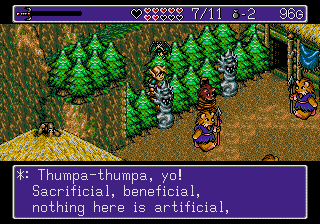 Landstalker was the first action RPG I played on the Genesis. Needless to say, it was completely different than anything I had ever played before. Games like Crusader of Centy and possibly Beyond Oasis probably would have better matched my tastes back then, but I’ve actually grown to love Landstalker most. Its most recognizable aspect – the isometric view – has always been a bit of a sore point for fans, but I like that it makes the game stand out. Beyond the unique viewpoint, the game features all the genre fixings you could hope for. You have hearts, which actually feel more like a basic HP system than any traditional Zelda game, lengthy dungeons filled with traps and puzzles, and a silly story to tie it all together.
Landstalker was the first action RPG I played on the Genesis. Needless to say, it was completely different than anything I had ever played before. Games like Crusader of Centy and possibly Beyond Oasis probably would have better matched my tastes back then, but I’ve actually grown to love Landstalker most. Its most recognizable aspect – the isometric view – has always been a bit of a sore point for fans, but I like that it makes the game stand out. Beyond the unique viewpoint, the game features all the genre fixings you could hope for. You have hearts, which actually feel more like a basic HP system than any traditional Zelda game, lengthy dungeons filled with traps and puzzles, and a silly story to tie it all together.
Perhaps my favorite aspect of Landstalker is its colorful world. Everything in Landstalker has a cartoonish charm. Thanks to the isometric aspect, more detail is given to character models than most else found in the 16-bit era. Does the isometric aspect make the game artificially difficult in some areas? Sure, but there’s plenty good to go with the bad. I so loved the world, dungeons, and gameplay that I purchased Dark Savior pretty close to launch, a mistake I still regret. My expectations were understandably high. At least the wonderful Alundra somewhat helped carry on Landstalker‘s legacy. Every Genesis owner, action RPG fan or not, should own a copy of Landstalker.
Devil’s Course By Doug Jackson
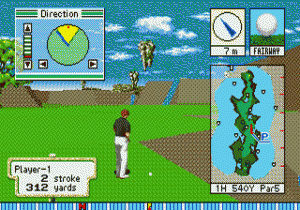 As many of you know, I had to step down as staff writer a while back, there were too many things in my personal life that left me with no time or energy to write much. I still enjoy writing obscure game reviews and recently have had some time free up. My schedule is not nearly as hectic now, so I decided to start writing some more. I started back up with a review of The Adventures Of Rocky & Bullwinkle And Friends (I know, don’t even ask, I somehow manage to come up with the most wonderful games to come out of a dry spell with) and knew that I needed to get through my backlog of games to review. I told all of you that I would get a review of Devil’s Course done, and I’m starting that game back up again. I came home from a long 12-hour day at work and needed to take a break before going to bed for the night. I hooked up my spare Genesis, since I needed that one since it’s modded, and Devil’s Course is region-locked. I had the intent of playing it for a while and reacquainting myself with it, but I was just out of energy for the night. I ended up turning it on and just listening to the soundtrack in the music test. I know, this is probably one of the most pointless roundtable entries I’ve ever written, but it’s just such a great soundtrack that’s totally obscure and one of my favorite on Sega’s 16-bit console, so I couldn’t help myself. I have renewed my interest in getting this review finished, so look forward to seeing it soon!
As many of you know, I had to step down as staff writer a while back, there were too many things in my personal life that left me with no time or energy to write much. I still enjoy writing obscure game reviews and recently have had some time free up. My schedule is not nearly as hectic now, so I decided to start writing some more. I started back up with a review of The Adventures Of Rocky & Bullwinkle And Friends (I know, don’t even ask, I somehow manage to come up with the most wonderful games to come out of a dry spell with) and knew that I needed to get through my backlog of games to review. I told all of you that I would get a review of Devil’s Course done, and I’m starting that game back up again. I came home from a long 12-hour day at work and needed to take a break before going to bed for the night. I hooked up my spare Genesis, since I needed that one since it’s modded, and Devil’s Course is region-locked. I had the intent of playing it for a while and reacquainting myself with it, but I was just out of energy for the night. I ended up turning it on and just listening to the soundtrack in the music test. I know, this is probably one of the most pointless roundtable entries I’ve ever written, but it’s just such a great soundtrack that’s totally obscure and one of my favorite on Sega’s 16-bit console, so I couldn’t help myself. I have renewed my interest in getting this review finished, so look forward to seeing it soon!
Bomboy By Greg Jurkiewicz
Given that I often make covers for lesser known, unlicensed Genesis games, like unreleased titles and obscure pirate games and such, I get to play all sorts of cool games that a lot of people don’t even know exist. The quality of these games varies of course, but it’s always rewarding to stumble upon a good one. Bomboy is one of those.
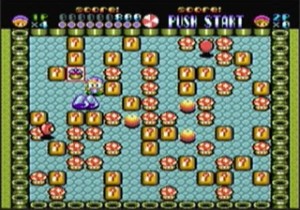 The game is a shameless Bomberman clone, there’s no question about it. I’ve never been much of a Bomberman fan, so I wasn’t expecting much from this game at first. That soon changed when I started playing it to get screenshots for the back cover. The game, despite its simple presentation, plays very well. There is a great selection of power-ups including upgrades that let you walk through walls, remote mines, multiple bomb drops, and the typical explosion upgrades. I’m not sure if this is the same fare that licensed Bomberman games offer, as I’ve never spent too much time playing any, but regardless the power-ups are well implemented and make for exciting gameplay. The other thing that really stuck out about this game is the great music. Like with most Taiwanese games, the sound engine is probably stolen from some other game, but they certainly utilized it well. The game is divided in worlds that you travel through, and there’s even a nice overworld map that you move along as you progress through the game. Each of the worlds has five stages that you need to clear before progressing to the next one. Some of the world are quite creative, like the cow level where the destroyable walls are cows whose eyes bug out in a hilarious fashion as you explode them. Another world is a bizarre Super Mario reference with yellow question mark boxes, mushrooms and red pipes making up the walls.
The game is a shameless Bomberman clone, there’s no question about it. I’ve never been much of a Bomberman fan, so I wasn’t expecting much from this game at first. That soon changed when I started playing it to get screenshots for the back cover. The game, despite its simple presentation, plays very well. There is a great selection of power-ups including upgrades that let you walk through walls, remote mines, multiple bomb drops, and the typical explosion upgrades. I’m not sure if this is the same fare that licensed Bomberman games offer, as I’ve never spent too much time playing any, but regardless the power-ups are well implemented and make for exciting gameplay. The other thing that really stuck out about this game is the great music. Like with most Taiwanese games, the sound engine is probably stolen from some other game, but they certainly utilized it well. The game is divided in worlds that you travel through, and there’s even a nice overworld map that you move along as you progress through the game. Each of the worlds has five stages that you need to clear before progressing to the next one. Some of the world are quite creative, like the cow level where the destroyable walls are cows whose eyes bug out in a hilarious fashion as you explode them. Another world is a bizarre Super Mario reference with yellow question mark boxes, mushrooms and red pipes making up the walls.
It’s a fun game and it’s always exciting to try to get to the next world to see what crazy things it has to offer.
Strider By The Coop
Back when the Genesis still had that new system smell, and programmers were continuing to learn how to get the system to do some interesting tricks, a friend of mine and I each found an upcoming game we were excited to get to play. For her, it was Strider, as she really enjoyed the arcade game. And for me, it was Thunder Force III, as I was a fan of the game that came before it, and of shmups in general. We were reading the magazines Mega Play and Electronic Gaming Monthly for our respectively bi-monthly and monthly dose of SEGA info, and waited patiently for the reviews to come in. Surely they both wouldn’t get the same scores, meaning one of us was going to win.
See, my friend and I had made a bet about which game would get the highest review scores. Both were being talked about in very positive ways for their previews and such, so we decided to have a little fun while we waited. No money was wagered, but bragging rights were on the line, damn it. And to a couple of sarcastic smart asses like us, getting to have them and gloat about our victory was nearly as good as money.
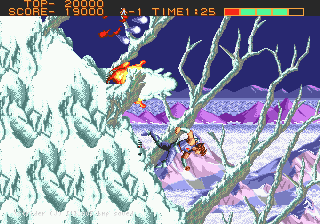 Well, as history has shown, I lost that bet. Strider repeatedly got scores of straight nines, while Thunder Force III got scores anywhere from seven to nine. Even GamePro rated Strider higher, not that anyone cared about their ratings. After all, they could give a game straight twos for everything but the fun factor, which would somehow get a five. But I digress, the reviews were in, leaving me hanging my head in defeat. Needless to say, she took those bragging rights and ran with them for weeks, teasing me about having a lowly little game that wasn’t as popular. But I took the loss with dignity and pride… by repeatedly making fun of her game’s cover art, and ribbing her via the amazon women’s voice sample in Strider that sounds like, “who’s a bitchy?”
Well, as history has shown, I lost that bet. Strider repeatedly got scores of straight nines, while Thunder Force III got scores anywhere from seven to nine. Even GamePro rated Strider higher, not that anyone cared about their ratings. After all, they could give a game straight twos for everything but the fun factor, which would somehow get a five. But I digress, the reviews were in, leaving me hanging my head in defeat. Needless to say, she took those bragging rights and ran with them for weeks, teasing me about having a lowly little game that wasn’t as popular. But I took the loss with dignity and pride… by repeatedly making fun of her game’s cover art, and ribbing her via the amazon women’s voice sample in Strider that sounds like, “who’s a bitchy?”
Yeah, not exactly the most adult thing to do, but I was a just young ‘un. What else was I gonna do in the face of such repeated verbal abuse? The funny part, is that she refused to play my game, and I refused to play hers, since they’d gone up against each other (snide winner vs sore loser in a way I suppose). Again, not exactly a grown up mentality on either of our parts, but eventually, curiosity won out with both of us. She played Thunder Force III and dug the music and parallax, while I played Strider and had fun with the boss fights and making my way through some of the levels. Granted, she sucked at my game, and my skills were garbage when I played hers, but we had a good time poking fun at each others dismal performances.
And just for the record, we stayed friends until I moved away about two years later, and even kept in touch for a while after that with the occasional letter, or even a visit once in a great while. In time though, we each went our separate ways. No fights or anything, just… “out of sight, out of mind,” basically. I guess that’s what happens when you only see someone once a year, if that. I occasionally wonder whatever became of her, as we all do from time to time with old friends we lose contact with. And as silly as it sounds, I still think of that bet nearly every time I pick up my own personal copy of Strider and give it a play. It’s kind of odd to have such memory attached to a game, really. But then again, so is hearing “who’s a bitchy?” over and over on the jungle stage.
Wonderboy in Monster World By Joseph C.
I recently picked up the Monster World Collection on XBLA at half-price over the Thanksgiving weekend. The main reason I grabbed it was for Monster World IV, but I couldn’t help starting with Wonderboy in Monster World which is the only one of the three titles I’ve actually beaten.
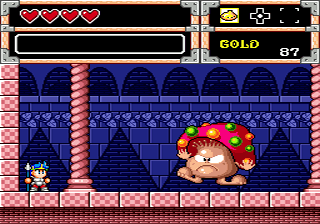 It has been a long time since I last played this but I was surprised at just how well I remember the game world. I guess I shouldn’t be, as it is one of my favourite childhood games, but I’ve forgotten many far more recent games much sooner. I think what really caught me this time was the music. Each area has unique background music and while most of the compositions are excellent, it can be surprising just how distinct they are. This is best seen right at the beginning with the sombre opening tune followed shortly by a very upbeat tropical track.
It has been a long time since I last played this but I was surprised at just how well I remember the game world. I guess I shouldn’t be, as it is one of my favourite childhood games, but I’ve forgotten many far more recent games much sooner. I think what really caught me this time was the music. Each area has unique background music and while most of the compositions are excellent, it can be surprising just how distinct they are. This is best seen right at the beginning with the sombre opening tune followed shortly by a very upbeat tropical track.
The gameplay still took me some getting used to as the main character, Shion tends to slip and slide. There are also some very unforgiving boss battles, but thankfully nothing that just feels unfair.
I must say that even after such a long time, I can remember exactly why I loved this as a child and I’m glad to see I still do today.

Recent Comments